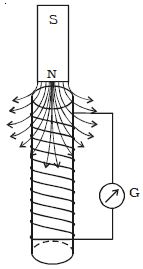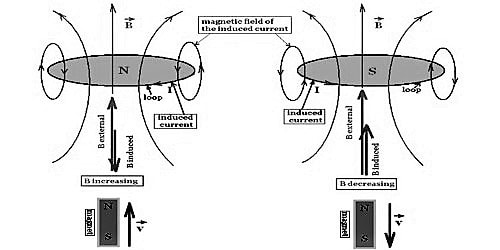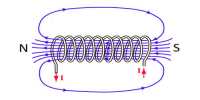Lenz’s Law– a Consequence of Conservation of Energy
Copper coils are wound on cylindrical cardboard and the two ends of the coil are connected to a sensitive galvanometer. A magnet is moved towards the coil (Figure). The upper face of the coil acquires north polarity.

Fig: Lenz’s law
Consequently, work has to be done to move the magnet further against the force of repulsion.
When we withdraw the magnet away from the coil, its upper face acquires south polarity. Now the work done is against the force of attraction. When the magnet is moved, the number of magnetic lines of force linking the coil changes, which causes an induced current to flow through the coil. The direction of the induced current. A repulsive force acts on the bar magnet due to the current induced in the coil. We have to do work in moving the North-pole of the magnet towards the coil. This energy is converted into electrical energy and then degenerate as heat in the loop by Joule heating produced by the induced current. Thus the additional effort is just malformed into electrical energy which is the law of conservation of energy.
Lenz’s law is always to oppose the motion of the magnet. The work done in moving the magnet is converted into electrical energy. This energy is dissipated as heat energy in the coil. If on the contrary, the direction of the current were to help the motion of the magnet, it would start moving faster increasing the change of magnetic flux linking the coil.
This results in an increase of induced current. Hence kinetic energy and electrical energy would be produced without any external work being done, but this is impossible. Therefore, the induced current always flows in such a direction to oppose the cause. Thus it is proved that Lenz’s law is the consequence of conservation of energy.
Lenz’s Law ensures that the mechanical energy of the wire is condensed by a similar amount of energy gained by the current. It does this by exerting a force on the wire contrasting the wire’s motion. This causes the wire to lose mechanical energy (its motion is impeded); it must do work alongside the induced magnetic field to produce current. Conservation of energy is the energy is transformed into electrical energy and then dissolute as heat in the loop by Joule heating formed by the induced current.
Lenz law essentially is that induced current always tends to oppose the cause which produces it. This mechanical work done is transformed into electrical energy. So in order to do work against opposing forces, we have to put additional effort. Likewise, when the magnet moves absent from the coil, the higher face of the coil acquires south polarity. This extra work leads to periodic change in magnetic flux, therefore, more current is induced. Again mechanical work has to be done to conquer the force of magnetism between the North Pole of the magnet and South Pole of the coil. This work done is transformed as electrical energy. Thus Lenz law is in accord with the law of conservation of energy.













